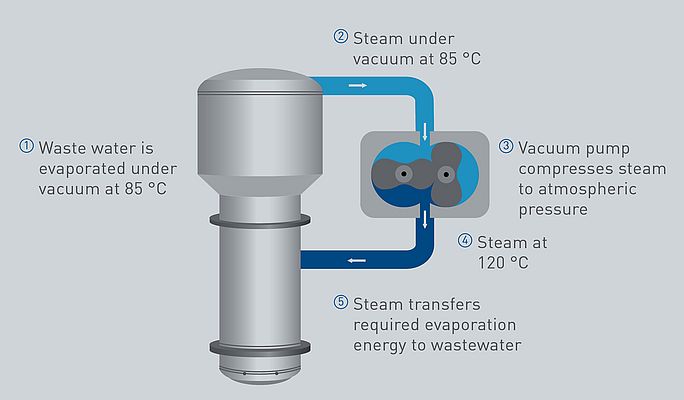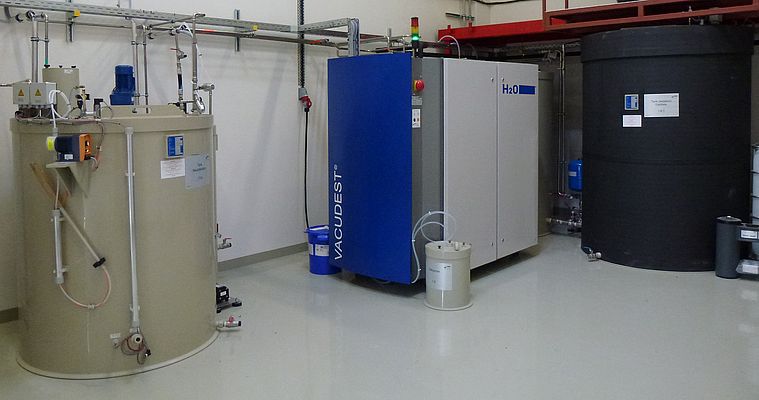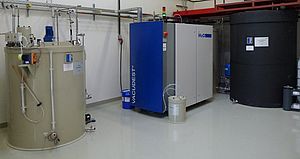During improvement of microstructures of materials such as metals and alloys industrial wastewater is generated. Bodycote decided to replace the conventional treatment of neutralization and ion-exchange by a vacuum distillation system, thus achieving a zero liquid discharge heat treatment process.
Bodycote is a worldwide leading provider of processing services for the improvement of properties of metals and alloys. Besides thermal processing Bodycote offers services for metal joining, surface technology and hot isostactic pressing.
In some of the processes chromium and nickel containing wastewater is generated which is not allowed to be disposed of into the public sewer system. Until recently the wastewater was neutralized and then treated in an ion exchanger to remove heavy metal pollution. The purified water was disposed of into the public sewer system. Next to the high cost for the regeneration, respectively the exchange of the ion exchanger columns, operation of the treatment system involves a very high work load. Since quality of the purified water was not good enough, recycling of the water was not possible, thus a high amount of fresh water was consumed.
Selection of a suitable processing technology
For already quite some time Bodycote was looking at alternatives to their existing waste¬water treatment process technology. The objective was to find a process producing less cost, consuming less fresh water and offering a high reliability. In addition Bodycote wants to standardize equipment, no matter where in the world it is installed. Especially for the wastewater treatment this is difficult, since regulations and disposal limit values vary strongly in different countries and regions. Because of that the idea came up to develop a zero liquid discharge process. Why shouldn’t one purify the water so far, that it can be recycled to the production, to be used as process water ? Further examination showed that vacuum distillation technology might fulfill these requirements.
Process development
Contact to H2O GmbH, a supplier of wastewater evaporators was established. In the first phase H2O studied the wastewater from Bodycote in their application centre for zero liquid discharge production. In laboratory scale a customized process for Bodycote was developed.
In the second phase economic viability was checked. It was found, that the operating cost of the VACUDEST wastewater evaporator was many times lower than those of the existing neutralization / ion exchanger system. Other processes like chemical physical treatment, where impurities are precipitated by suitable chemicals and filtered afterwards, have been eliminated because of too high operating cost.
Another strongpoint was the quality of the purified water after evaporation in a wastewater evaporator. In laboratory scale even the very high quality requirements of Bodycote have been exceeded. It seemed to be very probable that the purified water could be recycled to the production and used as rinsing water in surface technology processes.
Process verification
In the last phase the new innovative process had to be verified in production scale. H2O installed a demonstration system at one of Bodycote’s production sites. Over several weeks the wastewater generated in the surface technology processes was treated in the wastewater evaporator. After it was shown, that the quality or the purified water was very constant even after several weeks, successful trials for the recycling into the production process were carried out.
The recycling of the purified water has two additional advantages for Bodycote, having positive impact on operating cost of the complete production process. First of all the distillate leaving the VACUDEST wastewater evaporator is warm, thus the purified water must not be preheated prior to using it as rinsing water in the production process. As the distillate can be recycled, the fresh water consumption could be reduced by 95 %. In the past tense all this fresh water had to be demineralized prior to using it as rinsing water. As the distillate from the VACUDEST wastewater evaporator is already free of salts this process step is not needed any more cutting operating cost further.
Function principle of vacuum distillation
Vacuum distillation technology is based on the simple principle of separation of materials due to boiling point deviations. The industrial wastewater is evaporated. All substances having higher boiling points than water stay in the evaporation residue. This includes heavy metals, salts as well as oils, fats and tensides. Because the clean water evaporates, the evaporation residue volume is reduced to anywhere between 0.5 and 5 percent of the original wastewater volume. The emerging vapour is practically free of impurities. After condensation it can be used as process water in the production process. This creates a complete zero liquid discharge production.
Realization
The good results finally made Bodycote decide in favor of the new wastewater treatment approach when installing a complete new production line in one of their sites. Since October 2012 the wastewater generated in the process is treated in VACUDEST wastewater evaporator, supplied by H2O GmbH in Steinen. Jürgen Schmiz, project manager at Bodycote, summarizes: “The system works reliable and fulfills all our requirements to our full satisfaction. We could reduce operating cost and protect our environment at the same time. Now we have a zero liquid discharge production and don’t put any wastewater down the drain any more. In addition we reduced our fresh water consumption by more than 95 %.”
In the meantime a second site of Bodycote has exchanged their wastewater treatment system by a future proof VACUDEST wastewater evaporator. Other sites will follow in the nearer future.
Author: Jochen Freund Head of Product- & Business-Development




















